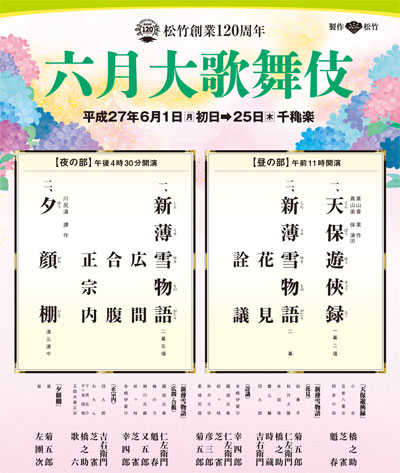| JUNE 2015 |
|
4 shows in T˘ky˘ (Kabukiza, National Theatre, Theatre Cocoon), 2 in Fukuoka (Hakataza), 1 in ďsaka (Sh˘chikuza) and 1 tour (Ichikawa Ennosuke Tour)!
|
| Kabukiza (T˘ky˘) |  |
| Dates | 1 ~ 25 June 2015 (Rokugatsu ďkabuki) June Grand Kabuki |
| MatinÚe |
|
| Evening |
|
| Casting |
Living National Treasure Onoe Kikugor˘, Living National Treasure Nakamura Kichiemon, Kataoka Nizaemon, Matsumoto K˘shir˘, Nakamura Hashinosuke, Nakamura Tokiz˘, Nakamura Shibajaku, Nakamura Kaishun, Ichikawa Sadanji, Nakamura Kinnosuke, Ichikawa Danz˘, ďtani Tomoemon, Band˘ Hikosabur˘, Nakamura Karoku, Nakamura Matagor˘, Ichikawa Komaz˘, Ichimura Kakitsu, Matsumoto Kingo, Kawarasaki Gonjűr˘, Sawamura Yoshijir˘, ďtani Keiz˘, Kataoka Matsunosuke, Nakamura Kash˘, Nakamura Baishi, Band˘ Minosuke, Nakamura Kotar˘, Nakamura Hayato, Nakamura Yonekichi, Nakamura Kunio, Nakamura Tanenosuke |
| Comments |
"Shin Usuyuki Monogatari" is staged as a t˘shi ky˘gen for the June Grand Kabuki at the Kabukiza. The rarely-staged "Kajiya" act is part of the production. Normally, even with the "Kajiya" act, it is possible to stage this drama within one program (either matinÚe or evening). The Sh˘chiku Company has decided to split the drama in two parts, "Hanami" and "Sengi" in the matinÚe, "Sannin Warai" and "Kajiya" in the evening program. If you plan to enjoy "Shin Usuyuki Monogatari" in its entirety, you have to purchase two tickets instead of one.
|
 |
|
|||
| Dates | 2 ~ 26 June 2015 (Rokugatsu Hakataza ďkabuki) June Hakataza Grand Kabuki |
||
| MatinÚe | |||
| Evening |
Geid˘ Ichidai Otoko |
||
| Casting |
Living National Treasure Sakata T˘jűr˘, Nakamura Ganjir˘, Nakamura Baigyoku, Nakamura Senjaku, Kataoka Hidetar˘, Ichikawa Chűsha, Nakamura T˘z˘, Nakamura Kazutar˘, Ichikawa En'ya, Nakamura Kikaku, Nakamura Jűjir˘, Nakamura Matsue, Nakamura Kamenoj˘ |
||
| Comments |
Nakamura Ganjir˘ IV celebrates his shűmei in Fukuoka at the Hakataza! Living National Treasure Sakata T˘jűr˘ does also his isse ichidai performance for the role of the courtesan Ohatsu in the drama "Sonezaki Shinjű":
|
||
| Sh˘chikuza (ďsaka) |
| Dates | 13 ~ 26 June 2015 (Rokugatsu Hanagata Kabuki) June Young Actors Kabuki |
| Program |
Waki Noboru Mizu-ni Koi Taki (Koi Tsukami) |
| Casting |
Kataoka Ainosuke, Ichikawa Omez˘, Kamimura Kichiya, Arashi Kitsusabur˘, Ichikawa Juen, Nakamura Mantar˘, Onoe Ukon |
| Comments |
Kataoka Ainosuke as zagashira in ďsaka at the Sh˘chikuza!
|
|
|||
| Dates | 4 ~ 21 June 2015 | ||
| Program | |||
| Casting |
Ichikawa Ebiz˘, Ichikawa Ukon, Kataoka Ichiz˘, Ichikawa Kudanji |
||
| Comments |
Third edition of the ABKAI (Ebikai in Japanese), a gala for the young star Ichikawa Ebiz˘. Ichikawa Ebiz˘ is assisted by Miyamoto Amon (production and stage direction) and Miyazawa Akio (screenplay). Two newly-created drama will be staged. "Ryűgű Monogatari" is about the legend of Urashima Tar˘, a fisherman who, according to the legend rescued a turtle and was rewarded for this with a visit to the palace of the Dragon God under the sea. He stayed there for three days and, upon his return to his village, found himself 300 years in the future. "Momotar˘ Oni-ga-Shima Gaiden" is about the legend of Momotar˘, literally the Peach Boy, who came to Earth inside a giant peach and who successfully fought a band of demons on a distant island named Oni-ga-Shima. |
||
| National Theatre (T˘ky˘) |
| Dates | 2 ~ 24 June 2015 (Rokugatsu Kabuki Kansh˘ Ky˘shitsu) June Kabuki Appreciation Class |
| Program | |
| Casting | |
| Comments |
Educational program at the National Theatre called Kabuki Kansh˘ Ky˘shitu ('Kabuki Appreciation Class'). This is a very interesting formula for the beginners because there is lively presentation on stage of Kabuki or some aspects of the art like music, stage tricks or fighting scenes. It is followed by the drama "Tsubosaka".
|
| Ichikawa Ennosuke Tour | |
| Dates | 2 ~ 24 June 2015 (Ichikawa Ennosuke Tokubetsu Buy˘ K˘en) Ichikawa Ennosuke Special Dance Performances |
| Program |
Kabuki no Mikata |
| Casting |
Ichikawa Ennosuke, Ichikawa Emiya, Ichikawa Emisabur˘, Ichikawa Monnosuke |
| Comments |
A 12-venue Buy˘ tour for Ichikawa Ennosuke, Ichikawa Emiya, Ichikawa Emisabur˘ and Ichikawa Monnosuke. They perform at Haneda Airport the 6th of June! They perform in Ky˘to at the Shunjűza from the 12th to the 14th of June. The Shunjűza is located within the Ky˘to University of Arts and Design (Ky˘to Z˘kei Geijutsu Daigaku). They perform at the Yachiyoza from the 19th to the 21st of June. They perform at the Asakusa K˘kaid˘ from the 23rd to the 24th of June. |
|
|
| Contact | Main | Top | Updates | Actors | Plays | Playwrights | Programs | Links | FAQ | Glossary | Chronology | Illustrations | Prints | Characters | Derivatives | Theaters | Coming soon | News |

